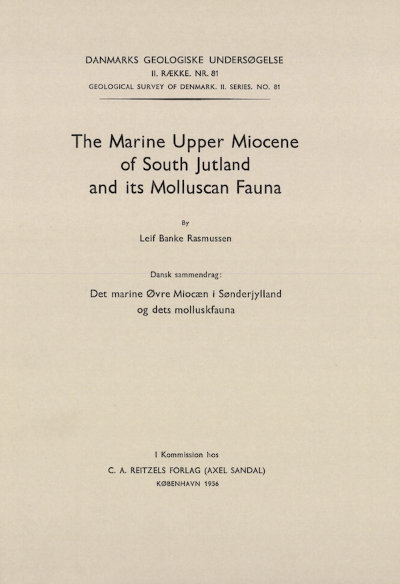The Marine Upper Miocene of South Jutland and its Molluscan Fauna
DOI:
https://doi.org/10.34194/raekke2.v81.6871Abstract
A description is given of five Tertiary exposures in South Jutland: Gram, Spandetgaard, Ravning, Storlund and Tornskov.
At all these places there are or have been brickworks pits in marine mica-clay: Gram clay. Sandy sediments have also been found at Gram. The molluscan fauna from Gram, Spandetgaard and Ravning is described in detail; a variation-statistical analysis is also given of the Astarte reimersi populations from all three localities. The 65 species described are employed as a basis for a biostratigraphical evaluation, with the following result: The fauna at Spandetgaard and Ravning is of the same character as that at Gram and comprises exactly similar populations of species. They must accordingly be assumed to be contemporaneous.
The two types of sediments on the whole contain the same molluscan fauna. About 14 species are dominant in the Gram clay, about 5 in the silty sediments. The age difference between them can be only slight. The fauna in all three localities must be determined as before as of Upper Miocene age, and it is closely associated with the molluscan fauna in the North German "Glimmerton".
The following species may for the present be employed as index fossils in the Upper Miocene of the North Sea Basin:
Sipho distinctusAquilofusus eximius - A. semiglaber
Astarte vetula - A. reimersi. The author makes a critical examination of the subdivision of the Upper Miocene in North Germany and considers Staesche's "Giihlitz-Mecklenburger Stufe" and Thiele's "Basisschichten" invalid.
He points out that less common species must be employed with caution in the stratigraphical evaluation, whereas species with a large individual number provide a better foundation for conclusions.
The most common molluscan species at Langenfelde and an as yet almost unstudied locality at Maade, east of Esbjerg, are compared and the similarities singled out. The faunas from Maade and Gram are then compared and the differences underlined.
The conclusion to be drawn from the author's inquiry on the whole is that the molluscan fauna does not seem to provide arguments sufficiently tenable in favour of a more exact biostratigraphic placing of the occurrences at Gram, Spandetgaard and Ravning in relation to the whole Upper Miocene complex in the North Sea Basin.
The relation of the Gram fauna to the Neogene in the rest of Europe and North Africa is examined quite superficially, a more detailed study being postponed until the molluscan fauna in the Danish Upper Miocene as a whole has been completely analyzed. Nevertheless the author maintains that the Gram fauna and its equivalents may best be placed in the period between the Tortonian and the Plaisancien.
Downloads
Published
Issue
Section
License
This article is distributed under a CC-BY 4.0 licence, permitting free redistribution and reproduction for any purpose, even commercial, provided proper citation of the original work. Author(s) retain copyright over the article contents.


